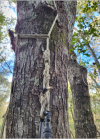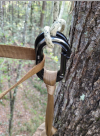I haven't posted in a long time and am sitting in a tree in Ohio reading this.
Don't think I've heard of this before but my buddy was here with me last week and he blew up a Ropeman1. Spring blew up. It wouldn't hold itself on the line without weight on it. He texted me he was half way up a tree. I know he carries a piece of 9mm for self rescue since that LW Climber Blew Up on Me a couple years ago so I told him to tie a prusik on his tether till I could get him a new ascender.
I carry and extra tether and a Beal jammy with me just in case I need it.
So when I made it to him and gave him the other tether with a duck on it he was already 25' up happy as a clam.
I've got Ropeman1 don't use any more because of line size. I have a Kong Duck that I like better than Ropeman1. But my favorite is my CT Rollinglock. Just Saying.
Sent from my SM-S918U using Tapatalk
Don't think I've heard of this before but my buddy was here with me last week and he blew up a Ropeman1. Spring blew up. It wouldn't hold itself on the line without weight on it. He texted me he was half way up a tree. I know he carries a piece of 9mm for self rescue since that LW Climber Blew Up on Me a couple years ago so I told him to tie a prusik on his tether till I could get him a new ascender.
I carry and extra tether and a Beal jammy with me just in case I need it.
So when I made it to him and gave him the other tether with a duck on it he was already 25' up happy as a clam.
I've got Ropeman1 don't use any more because of line size. I have a Kong Duck that I like better than Ropeman1. But my favorite is my CT Rollinglock. Just Saying.
Sent from my SM-S918U using Tapatalk
Last edited:



